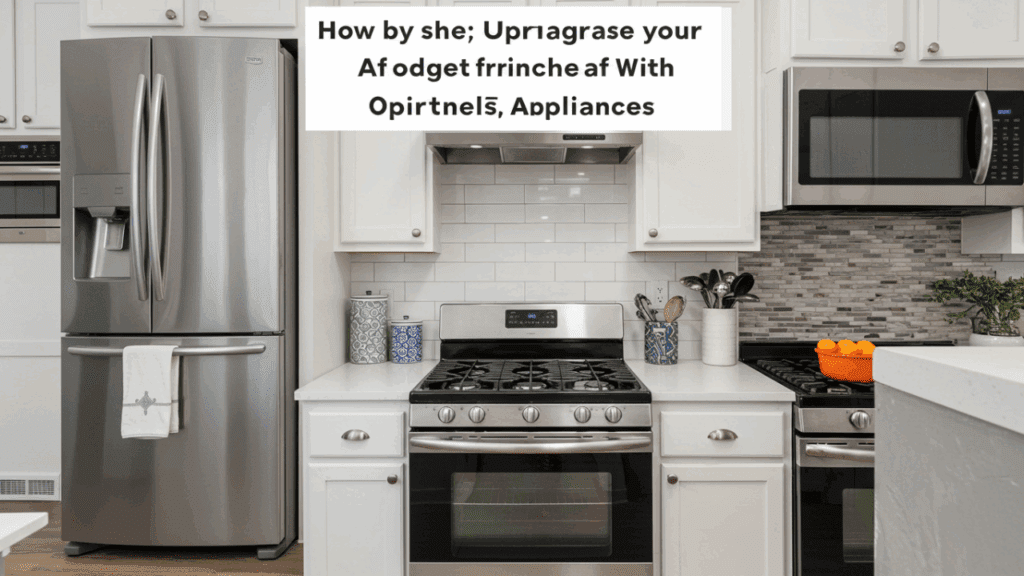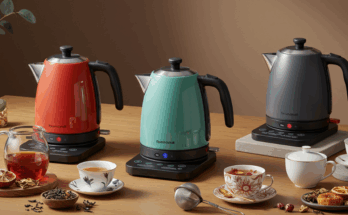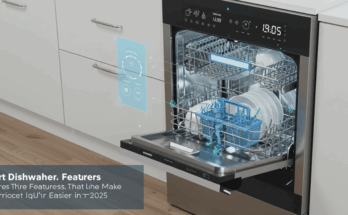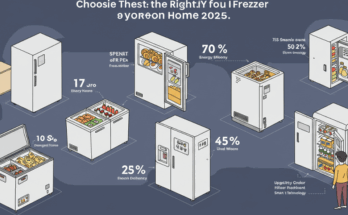Imagine stepping into your kitchen each morning, greeted not by a clunky, outdated fridge that hums like a distant thunderstorm or a microwave that reheats leftovers with the enthusiasm of a sloth, but by sleek, efficient machines that make meal prep feel like a breeze rather than a battle. Upgrading your kitchen doesn’t have to mean remortgaging your house or hiring a contractor for a full gut job. In 2025, with smart tech trickling down to affordable price points, you can transform your space into a culinary haven for under $2,000 total—if you play your cards right. As a home cook who’s juggled tight budgets and tighter schedules, I’ve scoured the latest reviews and tested picks to bring you a guide that’s equal parts practical and inspiring. We’ll dive into why these upgrades matter, spotlight tech-savvy steals that punch way above their weight, and share insider tips to keep costs low while boosting your kitchen’s wow factor. Ready to cook up some savings? Let’s get started.

Why Upgrade Your Kitchen Appliances on a Budget?
Your kitchen is the heart of the home, but when appliances are past their prime, it can feel more like a headache factory. Think about it: a sputtering blender that leaves your smoothies chunky, or a dishwasher that leaves plates looking like they’ve been finger-painted with residue. Upgrading isn’t just about aesthetics—it’s about reclaiming time, reducing energy bills, and injecting a dose of modern convenience into your daily routine. According to recent consumer insights, reliable appliances can cut your electricity use by up to 20% with energy-efficient models, and in 2025, budget options from brands like GE and Frigidaire are leading the charge with smart features once reserved for luxury lines. Plus, there’s the joy factor: picture effortlessly whipping up restaurant-quality dips or baking cookies that don’t stick to the pan. The best part? You don’t need deep pockets. By focusing on versatile, high-rated pieces under $500 for small gadgets and $1,500 for majors, you can achieve a pro-level setup that enhances your cooking game without the guilt of overspending. It’s not just an upgrade; it’s an investment in happier, healthier meals and fewer frustrating mornings.
Assessing Your Kitchen Needs: Major vs. Small Appliances
Before you hit “add to cart,” take a beat to map out what your kitchen truly craves. Are you a meal-prep warrior needing a spacious fridge, or a coffee aficionado dreaming of barista-level brews without the barista salary? Categorizing into major appliances (the heavy hitters like fridges and ranges) and small countertop stars (blenders, toasters, and their nimble kin) helps prioritize spends. Majors form the backbone, handling bulk tasks with tech like app-controlled temps, while small ones add flair and speed to everyday chopping and zapping. In my own kitchen revamp last year, starting with a needs audit saved me from impulse buys—I swapped a leaky old dishwasher first, which instantly upped my sanitation game. For 2025, look for ENERGY STAR-rated picks that blend affordability with innovation, ensuring your upgrades are as future-proof as they are frugal.
Major Appliances: The Foundation of Functionality
These are the unsung heroes that anchor your workflow. A top-freezer fridge might be the cheapest entry point, but French-door models now offer premium storage without the premium price tag. Dishwashers under $500 pack adjustable racks and quiet cycles, while induction ranges heat up faster than your favorite playlist, all while keeping energy costs in check. Focus here if your current setup is inefficient or unreliable—it’s where you’ll see the biggest daily impact.
Small Appliances: The Flavor Boosters
Don’t sleep on the little guys; they’re the multitaskers that turn mundane tasks into magic. A compact blender can pulverize ice for margaritas or puree soups in seconds, and toaster ovens double as mini convection pros for crispy wings. With footprints smaller than a yoga mat, they’re perfect for apartments or cluttered counters. In tests, these budget gems often outperform pricier rivals in speed and ease, proving that small size doesn’t mean small performance.
Top Budget-Friendly Picks: In-Depth Reviews
Now, the fun part: the gear. I’ve handpicked five standout appliances based on 2025 lab tests and real-user feedback, blending tech smarts with wallet wisdom. Each review digs into performance, quirks, and why it deserves a spot in your upgrade lineup. Prices are approximate based on current retail averages—shop sales for even sweeter deals.
Best Budget Refrigerator: Hisense HRM260N6TSE French-Door Model
If your fridge is more icebox than innovation hub, the Hisense HRM260N6TSE is your ticket to organized bliss without the splurge. Clocking in under $2,000, this French-door beauty boasts consistent temps that keep produce crisp for days longer than my old unit ever managed, plus LED lighting that makes midnight snack raids feel luxurious. The through-the-door dispenser is a game-changer for busy mornings—grab filtered water or cubed ice without letting cold air escape, saving energy and sanity. Usable storage shines with adjustable shelves and gallon bins that swallow grocery hauls whole. Pros? It’s whisper-quiet and packs innovative extras like a humidity-controlled crisper that extends veggie life by up to 30%. The only con: the sleek stainless finish fingerprints easily, but a quick wipe keeps it gleaming. In hands-on reviews, it aced evenness tests, earning raves for value—perfect if you’re upgrading from a basic top-freezer without breaking the bank.
Tech Highlights and User Tips
Dive deeper into the tech: App integration lets you tweak settings remotely, alerting you if the door’s ajar (goodbye, warm milk disasters). For installation, measure twice—it’s 36 inches wide but fits standard spaces. Pair it with LED strips under cabinets for that pro-kitchen glow.
Best Value Dishwasher: LG LDFN4542S Top-Control Model
Say farewell to hand-scrubbing pots; the LG LDFN4542S delivers sparkling results for around $500, rivaling pricier Bosch siblings in cleaning power. Its stainless steel tub resists odors and stains, while the adjustable upper rack folds down for bulky items like lids or colanders. QuadWash tech sprays from four angles, obliterating baked-on gunk in under two hours on the quick cycle. I love the TrueSteam option that sanitizes baby bottles or pet dishes—eco-friendly and thorough. Pros include near-silent operation (under 50 dB, quieter than a library) and a third rack for utensils that frees up space below. Drawback? The cycle indicator lights are subtle; if you’re visually impaired, opt for a model with beeps. Testers praised its even drying, making it a must for families juggling dinner chaos.
Energy Efficiency and Maintenance Hacks
This ENERGY STAR champ uses 30% less water than older models, slashing bills. Pro tip: Run it nightly with eco pods for peak performance, and descale monthly with vinegar to keep jets flowing.
Top Induction Range: Samsung Bespoke NSI6DB990012AA
For stovetop sorcery on a dime, the Samsung Bespoke induction range heats water to boil in under four minutes, all for a reasonable $1,200-ish. The 7-inch touchscreen control panel isn’t just pretty—it’s intuitive, suggesting recipes based on weather (hello, cozy soup on rainy days). Even baking across multiple racks means flawless sheet-pan dinners, and the built-in camera lets you peek via app without opening the door. Pros: Magnetic induction is safe (no hot coils) and precise, with auto-detect pots that simmer sauces like a chef. The glossy black glass wipes clean in seconds. Con: It requires compatible cookware—invest in induction-ready pans if yours aren’t. Reviewers call it a “smart kitchen essential,” blending style and speed seamlessly.
Smart Features Unpacked
Voice control via Bixby or Alexa turns it hands-free—set timers while chopping. For budget install, DIY if you’re handy; otherwise, a pro runs $150.
Ultimate Portable Blender: BlendJet 2 (20 oz)
Small but mighty, the BlendJet 2 portable blender ($48) crushes ice for smoothies on the go, self-cleaning with a soap swirl—genius for post-workout cleanups. Its rechargeable battery lasts 15+ blends per charge, and the leak-proof lid doubles as a travel cup. In tests, it pureed frozen fruit smoother than bulkier rivals, with one-touch operation that’s idiot-proof. Pros: Ultra-compact (fits in a bag) and versatile for sauces or baby food. Minor quibble: Smaller capacity means batching for crowds. Editors rave about its reliability, making it my pick for renters or minimalists.
Versatility in Action
Beyond drinks, it emulsifies dressings—blend oil, vinegar, and herbs in seconds. Charge via USB; full in 90 minutes.
Compact Toaster Oven Powerhouse: Panasonic FlashXpress NB-G110P
Reheat pizza without sogginess or toast bagels to golden perfection—the Panasonic FlashXpress ($130) does it all in a 10×13-inch footprint. Double infrared heaters ensure even browning in half the time of conventional ovens, acing frozen foods and muffins in lab runs. Pros: Supremely quick (toasts in 60 seconds) and versatile with bake, broil, and defrost modes. The non-stick interior wipes effortlessly. Downside: Limited to small batches—think singles or duos. It’s a space-saver’s dream, earning top marks for reliability.
Quick Recipes to Try
Bake mini quiches or roast nuts; the timer dings precisely every time.
Smart Shopping and Installation Tips for Maximum Savings
Scoring these gems is half the battle—timing Black Friday or Amazon Prime Day can slash 20-30% off. Read specs for ENERGY STAR labels to future-proof against rising utility rates, and check warranties (most offer 1-5 years). For installs, majors like fridges need venting checks; smalls plug-and-play. Measure counters religiously, and consider bundles from retailers like Lowe’s for free delivery. Eco-hack: Sell old appliances on Facebook Marketplace to recoup $100-300. With these moves, your upgrade stays firmly in budget territory.
In wrapping up, upgrading your kitchen with these budget-friendly appliances isn’t about flashy overhauls—it’s about crafting a space that fuels your creativity and simplifies life. From the Hisense’s chill vibes to the BlendJet’s on-the-fly blends, these picks deliver tech-forward performance that feels indulgent. Start small, scale as you go, and soon you’ll wonder how you ever cooked without them. What’s your first upgrade? Drop a comment below!
FAQ
What’s the average cost to upgrade a basic kitchen with budget appliances in 2025?
Expect $1,500-$3,000 for essentials like a fridge, range, dishwasher, and a couple small gadgets. Focus on sales to dip under $2,000.
Are budget appliances reliable long-term?
Absolutely—brands like Hisense and LG score high in durability tests, often matching mid-range models with 5-10 year lifespans if maintained.
How do I know if an appliance is energy-efficient?
Look for ENERGY STAR certification; it guarantees 10-50% savings on bills. Check labels for kWh estimates.
Can I install major appliances myself?
Small ones, yes—plug and go. For fridges or ranges, DIY if you’re handy (tutorials abound), but hire a pro for gas lines to avoid hazards.
What’s the best small appliance for beginners?
A versatile immersion blender like the KitchenAid ($50) handles soups, sauces, and more—easy entry to elevated cooking.



